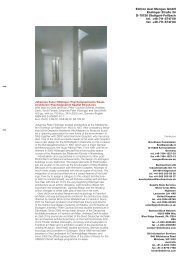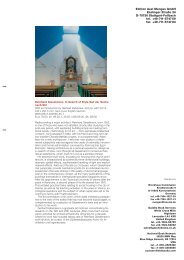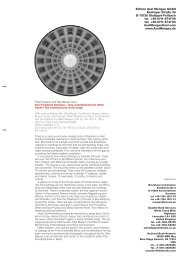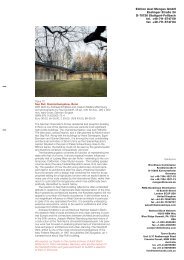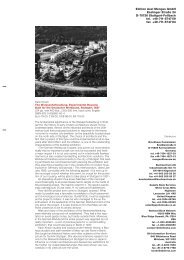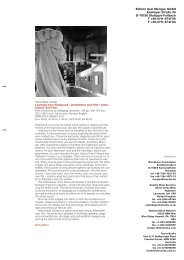Edition Axel Menges GmbH Esslinger Straße 24 D-70736 Stuttgart ...
Edition Axel Menges GmbH Esslinger Straße 24 D-70736 Stuttgart ...
Edition Axel Menges GmbH Esslinger Straße 24 D-70736 Stuttgart ...
You also want an ePaper? Increase the reach of your titles
YUMPU automatically turns print PDFs into web optimized ePapers that Google loves.
Paris, cover 27.08.2003 9:05 Uhr Seite 1<br />
The City of Light has long been an architectural innovator and showcase<br />
for France and her rulers. A site of strategic importance since the 3rd century<br />
BC, Paris flourished under the Romans, but subsequent Barbarian invasions<br />
meant that comparatively little remains of her Antique splendour. In<br />
the 6th century AD the Merovingian kings made Paris the seat of the realm,<br />
a status the city has retained bar the odd interruption throughout the centuries.<br />
By the 12th century, Paris was established as a political, economic,<br />
religious and cultural capital.<br />
Each epoch has left its mark on Paris: the churches of the Middle Ages<br />
and the Renaissance, the aristocratic hôtels particuliers of the 17th and 18th<br />
centuries, and the apartment, railway, industrial and office buildings of the<br />
19th and 20th. A centralization of power in the capital long ensured that<br />
Paris received more than its fair share of attention from princely »architectes<br />
manqués«, from the Bourbons through the Napoléons to Président Mitterrand.<br />
Baron Haussmann’s recasting of the city in the image of Napoléon III<br />
became the model of its age for urban development, and the phenomenon<br />
of the presidential »grands projets« in the 1980s and early 1990s provoked<br />
comment the world over. When not directly shaping the fabric of Paris themselves,<br />
its rulers have always kept tight control over the activities of others,<br />
with the result that Paris has developed under some of the strictest building<br />
regulations of any major city. Despite Paris’s much vaunted reputation as<br />
the cultural salon of Europe, a certain suspicion towards foreign architectural<br />
imports has characterized its development, and outside influences have<br />
always been adapted to local needs and indigenous modes of expression,<br />
a tradition which carried on until the postwar era and arguably continues<br />
today. The last decades of the 20th century have witnessed a rush to modernize<br />
and adapt a crumbling fabric to the exigencies of the electronic age.<br />
Andrew Ayers studied at the Bartlett School of Architecture and Planning,<br />
University College London, and now lives in Paris.<br />
39.00 Euro<br />
59.00 sfr<br />
28.00 £<br />
39.00 US $<br />
72.00 $A<br />
ISBN 3-930698-96-X<br />
9 783930 698967<br />
Andrew Ayers The Architecture of Paris <strong>Menges</strong><br />
Andrew Ayers<br />
The Architecture<br />
of Paris






